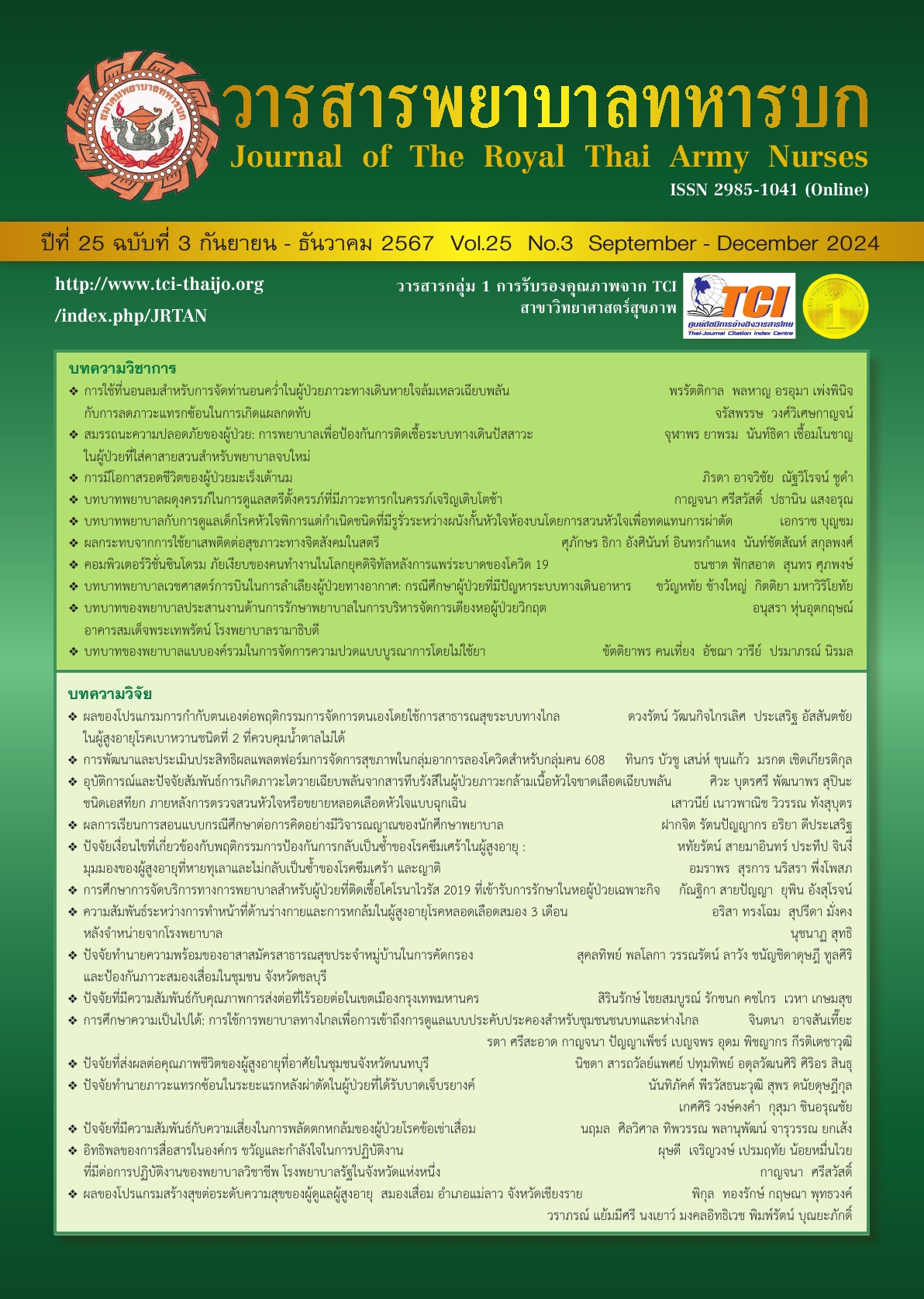Prevalence and Risk Factors of Musculoskeletal Disorders Among Intensive Care Unit Nurses: A Case Study in a Hospital, Bangkok
Keywords:
Musculoskeletal disorder, Ergonomic risk factor, Intensive care unit nursesAbstract
The purpose of this research is to reveal prevalence and risk factors of musculoskeletal disorders. The researcher distribute questionnaires and assess ergonomic risk factors for each type of work. The information obtained will be used to analyze relationships. The prevalence of musculoskeletal disorders in the past 12 months was 79.2% and 72.3% in the past 7 days, respectively. The highest affected region was lower back. Risk factors of musculoskeletal disorders include age, exercise habits, working hours and ergonomic risks. For each type of work, ergonomic risks in neck and back region were found to be associated with musculoskeletal disorder. Therefore, there must be improvement each type of working condition to reduce the level of ergonomic risk, especially the neck and back regions, Including workload and working hours to suit each individual. Training on proper working postures and exercise to prevent and reduce musculoskeletal disorders.
Downloads
References
Tariah H A, Nafai S, Alajmi M, Almutairi F, Alanazi B. Work-related musculoskeletal disorders in nurses working in the Kingdom of Saudi Arabia. Work. 2020; 65(2): 421-8.
Krishnan K S, Raju G, & Shawkataly O. Prevalence of Work-Related Musculoskeletal Disorders: Psychological and Physical Risk Factors. International Journal of Environmental Research and Public Health. 2021; 18(17): 9361, 1-11.
Luan HD, Hai NT, Xanh PT, Giang HT, Thuc PV, Hong NM, et al. Musculoskeletal Disorders: Prevalence and Associated Factors among District Hospital Nurses in Haiphong, Vietnam. Biomed Research International. 2018; 2018: 3162564, 1-9.
Thinkhamrop W, Sawaengdee K, Tangcharoensathien V, Theerawit T, Laohasiriwong W, Saengsuwan J, et al. Burden of musculoskeletal disorders among registered nurses: evidence from the Thai nurse cohort study. BioMed Central Nursing. 2017; 16:68, 1-9.
Ilce AO. Study on work-related musculoskeletal disorders in intensive care unit nurses. Anatolian Journal of Clinical Investigation. 2014; 8(2): 68-76.
Rehn B. Musculoskeletal disorders and whole-body vibration exposure among professional drivers of all-terrain vehicles [Medical dissertation]. Umea: Umea University; 2004.
Sezgin D, & Esin MN. Predisposing factors for musculoskeletal symptoms in intensive care unit nurses. International Nursing Review. 2015; 62(1): 92-101.
Yang S, Li L, Wang L, Zeng J, & Li Y. Risk Factors for Work-Related Musculoskeletal Disorders Among Intensive Care Unit Nurses in China: A Structural Equation Model Approach. Asian Nursing Research (Korean Society of Nursing Science). 2020; 14(4): 241-8.
Lin SC, Lin, LL, Liu, C J, Fang CK, & Lin MH. Exploring the factors affecting musculoskeletal disorders risk among hospital nurses. PLoS One. 2020; 15(4): e0231319, 1-20.
Jongkol P. An investigation into Taxi Drivers’ musculoskeletal pain and work-related risk factors. Nakhon Ratchasima: Suranaree University of Technology; 2010. (in Thai)
Bernard T E. Rodgers Muscle Fatigue Analysis. New York; 2006.
Chaput J P, McHill A W, Cox R C, Broussard J L, Dutil C, da Costa B G G, et al. The role of insufficient sleep and circadian misalignment in obesity. Nature Reviews Endocrinology. 2023; 19(2): 82-97.
McCormick R, & Vasilaki A. Age-related changes in skeletal muscle: changes to life-style as a therapy. Biogerontology. 2018; 19(6): 519-36.
Lee J G, Kim G H, Jung S W, Kim, S W, Lee J H, Lee K J. The association between long working hours and work-related musculoskeletal symptoms of Korean wage workers: data from the fourth Korean working conditions survey (a cross-sectional study). Annals of Occupational and Environmental Medicine. 2018; 30(1): 61-11.
Srisukkho N, Luksamijarulkul P, Chaiyanan S, & Morakotsriwan N. Prevalence and Severity of Low Back Pain in Nursing Personnel in a Hospital in Bangkok Metropolitan Administration. Journal of The Royal Thai Army Nurses. 2022; 23(1): 187-9.
Sato Y, Iwakiri K, Matsuo T, & Sasaki T. Impact of health literacy on health practices in the working life of young Japanese nurses and care workers. Industrial Health. 2021; 59(3): 171-9.
Moradpour Z, Rezaei M, Torabi Z, Khosravi F, Ebrahimi M, & Hesam G. Study of correlation between muscle fatigue assessment and cornell musculoskeletal disorders questionnaire in Shahroud Taxi Drivers in 2017: A descriptive study. Journal of Rafsanjan University of Medical Sciences. 2019; 17(11): 1031-42.
Robergs R A, Ghiasvand F, & Parker D. Biochemistry of exercise-induced metabolic acidosis. American Journal of Physiology-Regulatory, Integrative and Comparative Physiology. 2004; 287(3): R502-16.
Downloads
Published
How to Cite
Issue
Section
License
Copyright (c) 2024 Journal of The Royal Thai Army Nurses

This work is licensed under a Creative Commons Attribution-NonCommercial-NoDerivatives 4.0 International License.
บทความหรือข้อคิดเห็นใดใดที่ปรากฏในวารสารพยาบาลทหารบกเป็นวรรณกรรมของผู้เขียน ซึ่งบรรณาธิการหรือสมาคมพยาบาลทหารบก ไม่จำเป็นต้องเห็นด้วย
บทความที่ได้รับการตีพิมพ์เป็นลิขสิทธิ์ของวารสารพยาบาลทหารบก
The ideas and opinions expressed in the Journal of The Royal Thai Army Nurses are those of the authors and not necessarily those
of the editor or Royal Thai Army Nurses Association.






